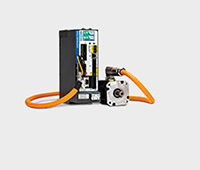 Zemission has developed a zero-emission catalytic burner for heating in electric and hybrid vehicles. The device promotes the uptake of plug-in electric vehicles (EVs) by increasing their driving range.
Zemission has developed a zero-emission catalytic burner for heating in electric and hybrid vehicles. The device promotes the uptake of plug-in electric vehicles (EVs) by increasing their driving range.
With EVs and plug-in hybrid EVs (PHEVs), the waste heat from internal combustion engines normally used to warm passengers is either not available or insufficient. This is creating a growing need for auxiliary cabin heaters. In cold climates with a -7° C, studies show that the battery of EVs suffer a decrease in range of up to 60%.
Some 3 million hybrid vehicles will be built by the year 2020, and an estimated 9 to 10 million by 2025. Rising sales of EVs and PHEVs are therefore creating a need for either fuel-operated or electric-powered auxiliary heaters. However, currently available fuel-operated heaters produce levels of emissions that do not comply with current regulations. And electric heaters drain the main battery of power, depleting vehicle range.
The EU-funded Horizon 2020 z-BURN project addressed this challenge by helping commercialize a novel burner developed by the Swedish company Zemission, which uses catalytic combustion to give clean, flameless combustion.
“We have developed and tested a patented device that is simple, silent, can be fuelled with any liquid biofuel and boasts superior efficiency with zero emissions,” said CEO and project coordinator Anders Vestin.
Catalytic combustion involves the oxidation of hydrocarbon fuel, which takes place in the presence of heat and a catalyst. There is no flame involved, and no nitrogen oxides are formed due to the relatively low temperature. Advantages include long life, robustness, and compact size. The burner can be used in autonomous heaters to avoid increased emissions and the rapid battery depletion experienced with off-the-shelf auxiliary heaters.
“For passenger vehicles, z-BURN offers a world-beating solution that minimises the impact of cold climates on passenger comfort and vehicle performance,” Vestin said. “For commercial vehicles z-BURN provides a solution with multiple applications like cabin heating, battery heating, and the heating of exhaust after treatment systems.”
End customers include hybrid vehicle owners around the globe; the burner will make a significant impact on driving range, as well as allowing the battery pack to be reduced in size.
“The project’s key result is a better understanding of the total market and the needs of our main customers and contact with new potential customers, it was also extremely valuable in updating our business plan. For example, we found there is also great need for this technology in heavy goods vehicles,” said Vestin.
z-BURN provides a better understanding of the market and the requirements of customers like the procurement and technical development departments of large automobile manufacturers, such as the Volkswagen group.
“We achieved a deeper appreciation of the main challenges currently facing the industry, including which type of vehicles will be early adaptors of the technology, and where there is the greatest willingness to invest in solutions. The next stage is to industrialize the heater and build the supply chain,” Vestin said.
Zemission
zemission.se
Filed Under: Green engineering • renewable energy • sustainability, MOTION CONTROL




